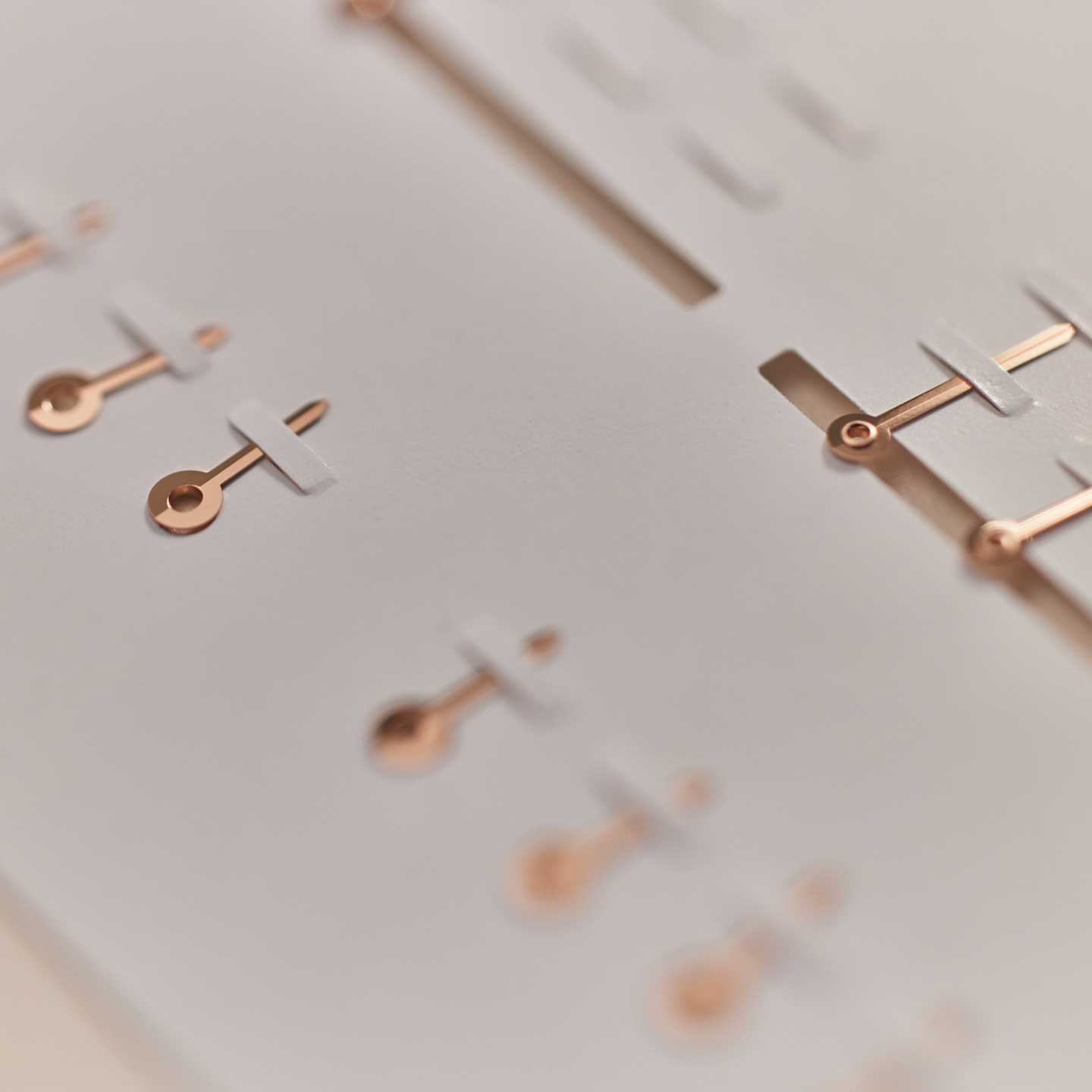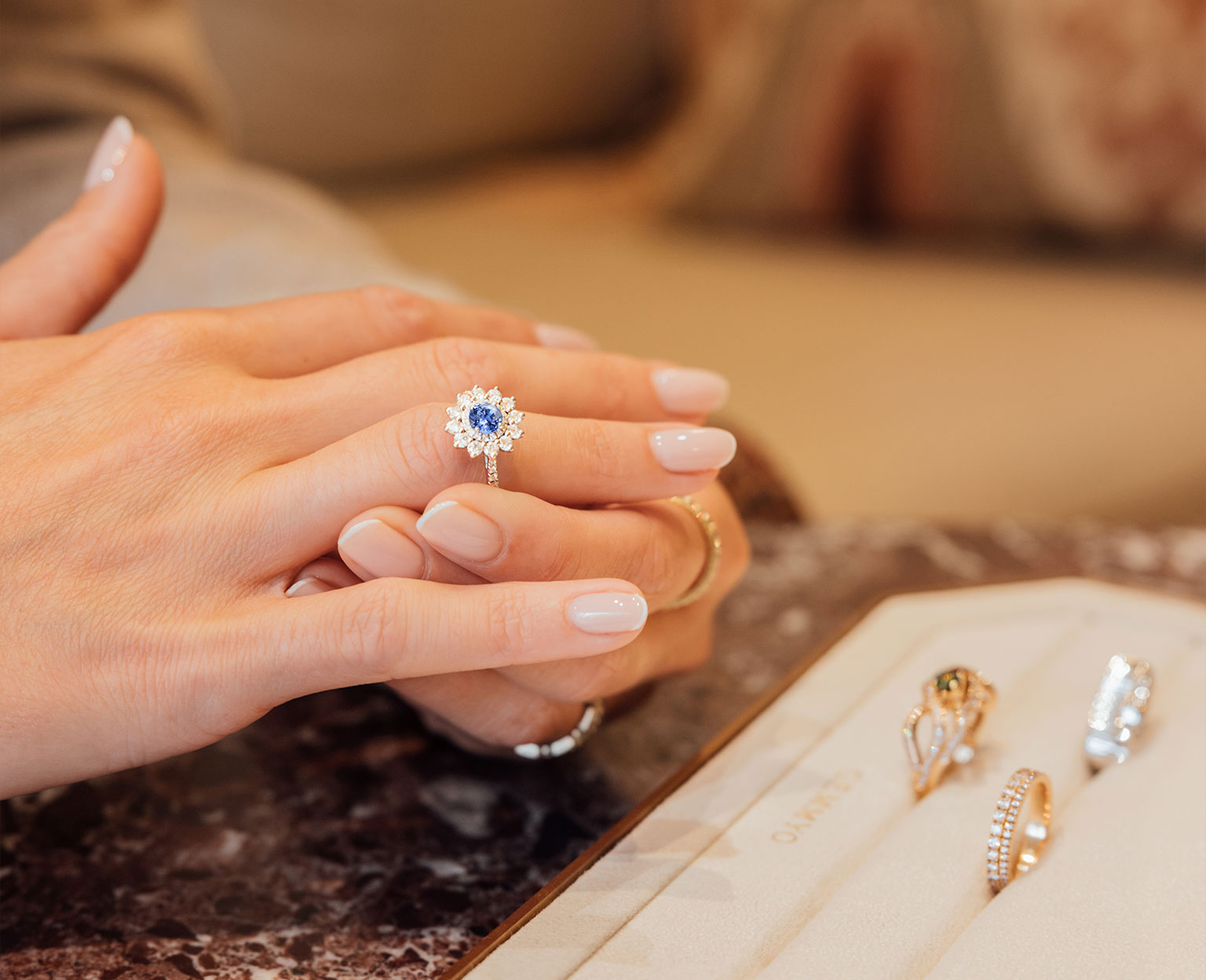You’re not a watchmaking specialist but you can appreciate beautiful watches?
You would like to know the meaning behind terms like movement, sapphire glass, or crown?
This guide is for you!
In this digital era, our phones tell the time instantaneously and with unbeatable precision, could you imagine that we still manufacture tens of millions of watches each year, in Switzerland for example?
It’s more than just a practical object, a watch is like a piece of jewelry. This accessory, beyond adding a touch of style to any outfit, has become, over time, an object coveted by many collectors.
But why does watchmaking spark such passion? What criteria define a “great watch”.
In a few lines, you’ll find the answers to all these questions!
Key concepts
Before making you specialists, let’s briefly discuss the watch’s history.
—— How old is the first watch?
Since antiquity, Man has needed to divide time to organize days.
Back then, tools were very basic, such as the clepsydra which allowed time to be measured by the flow of water. The first - well-known - sundials or even hourglasses allowed Man to measure time with more or less precision.
Did you know?
In 1492, during his journey to discover the Americas, Christopher Colombus boarded with an hourglass to measure the length of his trip. A sailor had to turn it over as soon as the sand had run out, every 30 minutes!
The history of the watch - as we know it today - starts in the 15th century with portable clocks conceived, as the name indicates, to be transported in a pocket or on a chain (the renowned pocket watch). Some time later, around 1510, a German watchmaker named Peter Henlein revolutionized the mechanism thanks to the mainspring which made it possible to reduce the size of watches and make them easier to carry… but very expensive and exclusive to the more fortunate. They will become more affordable and very popular in the 19th century, thanks to industrialisation.
The real turn occurred in the 17th century with the invention of the quartz movement, followed in 1778 by the creation of the first automatic watch by Abraham Louis Perrelet. Though these are technical exploits (no need to manually rewind a watch every night any more), these discoveries aren’t adopted by the general public. It isn’t until the 20th century and the end of the First World War that automatic watches (we’ll find out what these are in a moment, patience!) become popular. Soldiers start to wear them on their wrist, which - we must admit! - is much more practical to read time while piloting a plane or carrying weapons. A few years later, at the end of the 20th century, the first quartz bracelet watch sees the light and revolutionizes the watchmaking world with the precision of its movement.
Following this brief trip to the past, let’s return to the present.
Before becoming a perfect horophile - lover of watchmaking - let’s establish the basics with a few vocabulary words used to describe different elements of watch.
—— What watchmaking vocabulary should you know?
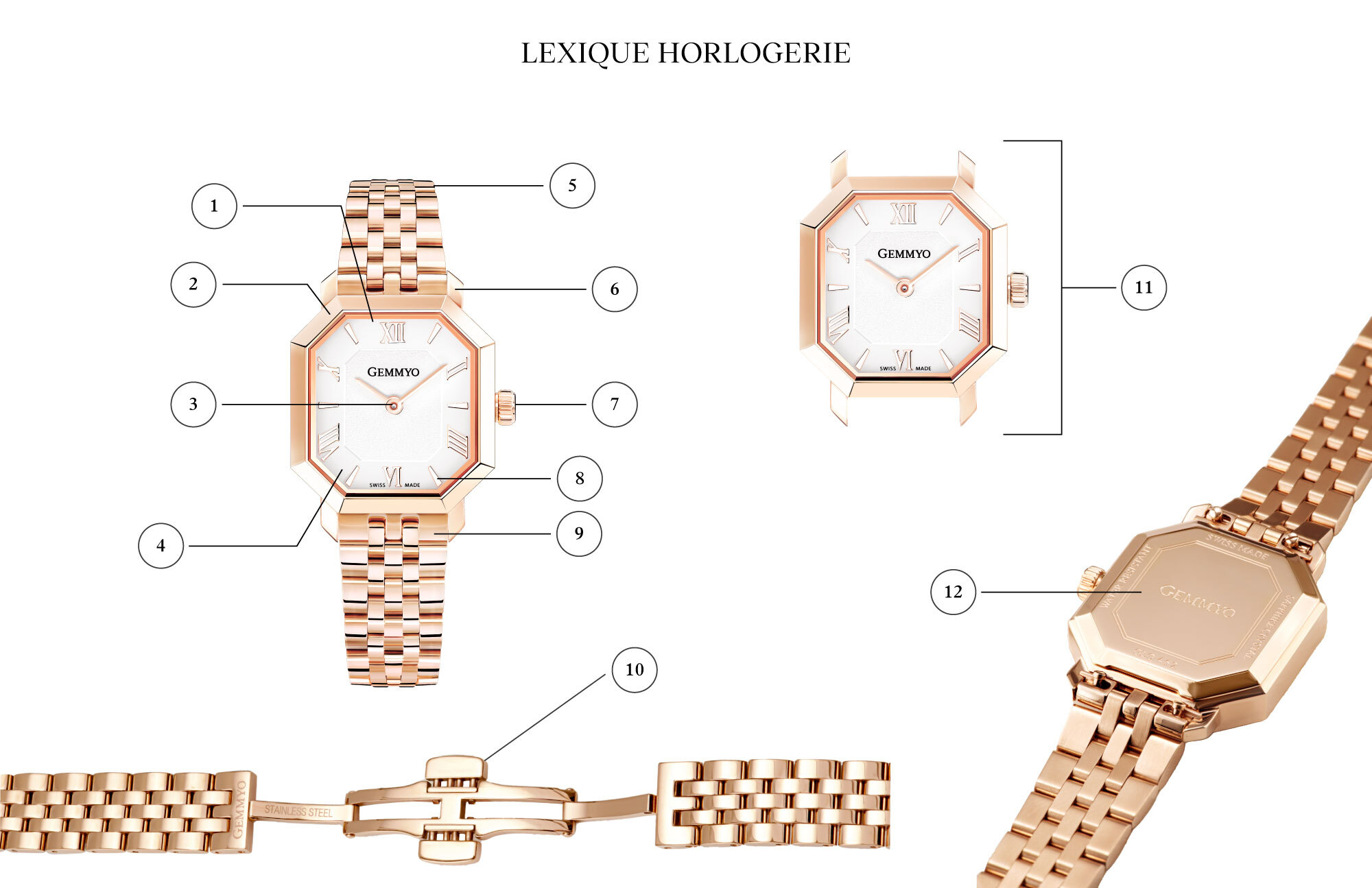
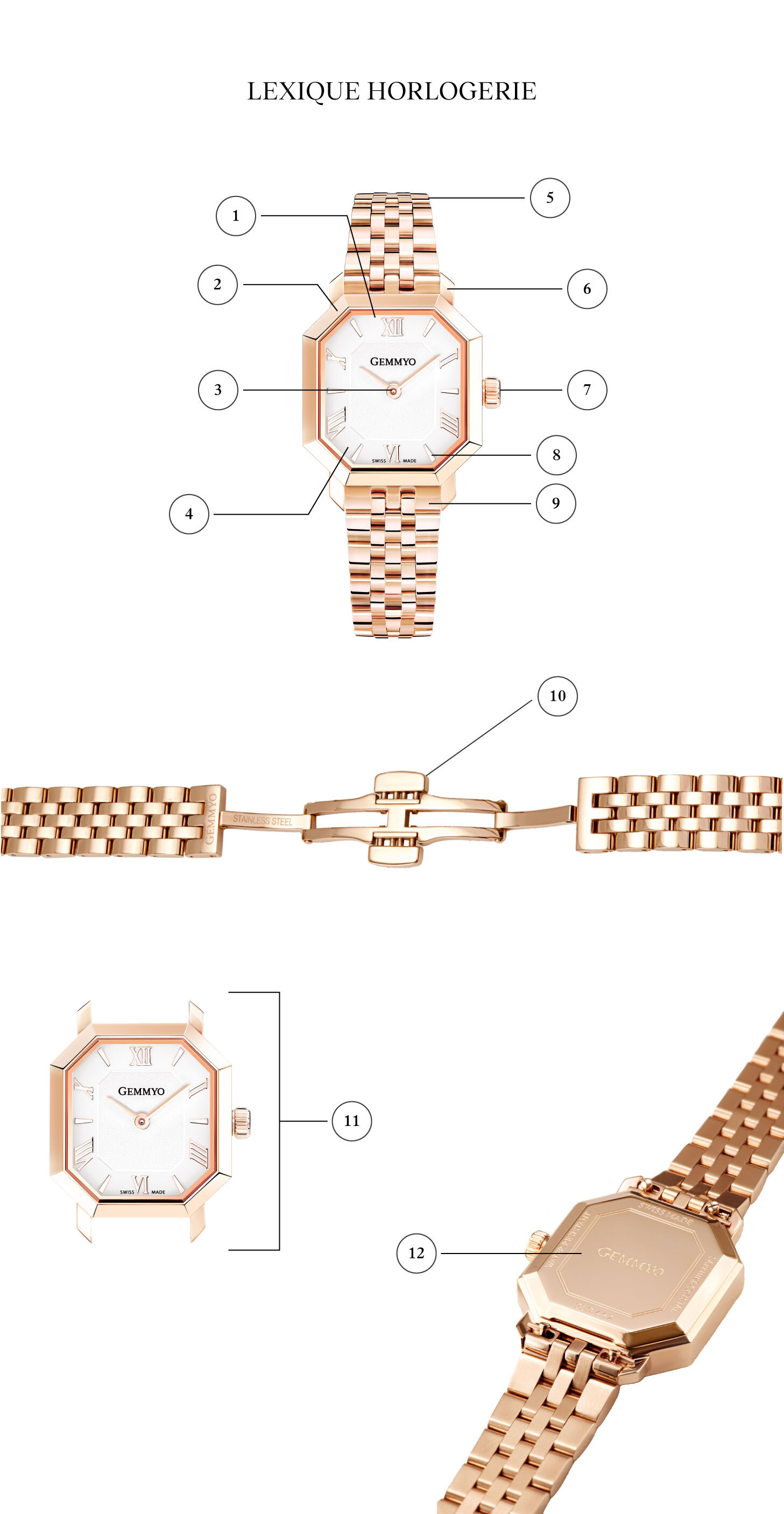
- Glass : protects the dial and let’s us read the time through it
- Bezel : surrounds the dial and holds the glass
- Hands : indicate the hours and minutes
- Dial : supports the markers
- Bracelet : attaches the watch to the wrist
- Horns : the pieces branching from the case on which the bracelet can be attached
- Crown : it is twisted to adjust the time on the watch
- Markers : indicate the position of each hour
- End link : the element at the bracelet’s extremity that joins links it to the case
- Buckle : opens and closes the bracelet
- Case or case middle : the main element containing the movement
- Back of the case : it maintains the movement at the back of the case
You are now capable of describing all of the elements that make a watch. But how does it work? Let’s open the case to see what is happening inside!
—— What is a movement?
The movement is what one might call the heart of the watch. It is the set of pieces that allow the hands to turn at a regular pace.
There exist three main types of movement in watchmaking:
-
The oldest is the manual mechanical movement that must be rewound manually everyday. Turning the crown (usually situated right of the case), rewinds the watch by creating mechanical energy. This energy is stored in a spring that will unwind little by little. The tension of this spring is controlled by gears (so that the energy isn’t released in one go). These little blocks aren’t foreign to you, they generate the famous “tick tock” we hear when we bring the case up to our ear.
Linked to what is called a balance, the gears allow it to oscillate at about 28 800 vibrations per minute. Imagine the speed! These oscillations are what allow the second hand to turn and thus to tell the time.
Once the energy has been used up, the crown needs to be rewound to restart the mechanism.Little tip : watchmakers recommend rewinding your watch at the same time daily to avoid a system malfunction.
-
The second is the automatic mechanical movement. As its name indicates, this movement is rewound automatically as long as it is worn on the wrist. It works similarly to the manual mechanical movement but it is equipped with a rotor. What use could it have?
This mass, often visible at the back of a watch, is particularly useful. It oscillates with each movement of the wrist, recharging the mechanism’s spring. No need to turn the crown everyday to ensure the mechanism works! However, if the watch isn’t worn for some time, the energy will no longer be sufficient for the mechanism to function (this is called the power reserve) and the crown will have to be turned manually to restart it. -
Finally, let’s turn our attention to the Quartz movement. This relatively modern movement, developed in the 70s, has a great advantage: it is both precise and terrifically reliable.
Does the name “quartz” remind you of anything? It is the same stone used in jewelry! The quartz crystal is particular as it produces energy in a natural way. This is called piezoelectricity. Discovered in the 19th century by Pierre de Jacques Curie, this term refers to the capacity of a material to generate an electric potential when exposed to a mechanical force. Simply put? A battery provides energy to stimulate the quartz which then vibrates (32 700 times per second!) at a regular frequency. This impressive regularity makes it the most precise movement in the watchmaking world.
Each of these movements has advantages and inconveniences. The choice then depends on your preferences in terms of style, functionality and budget.
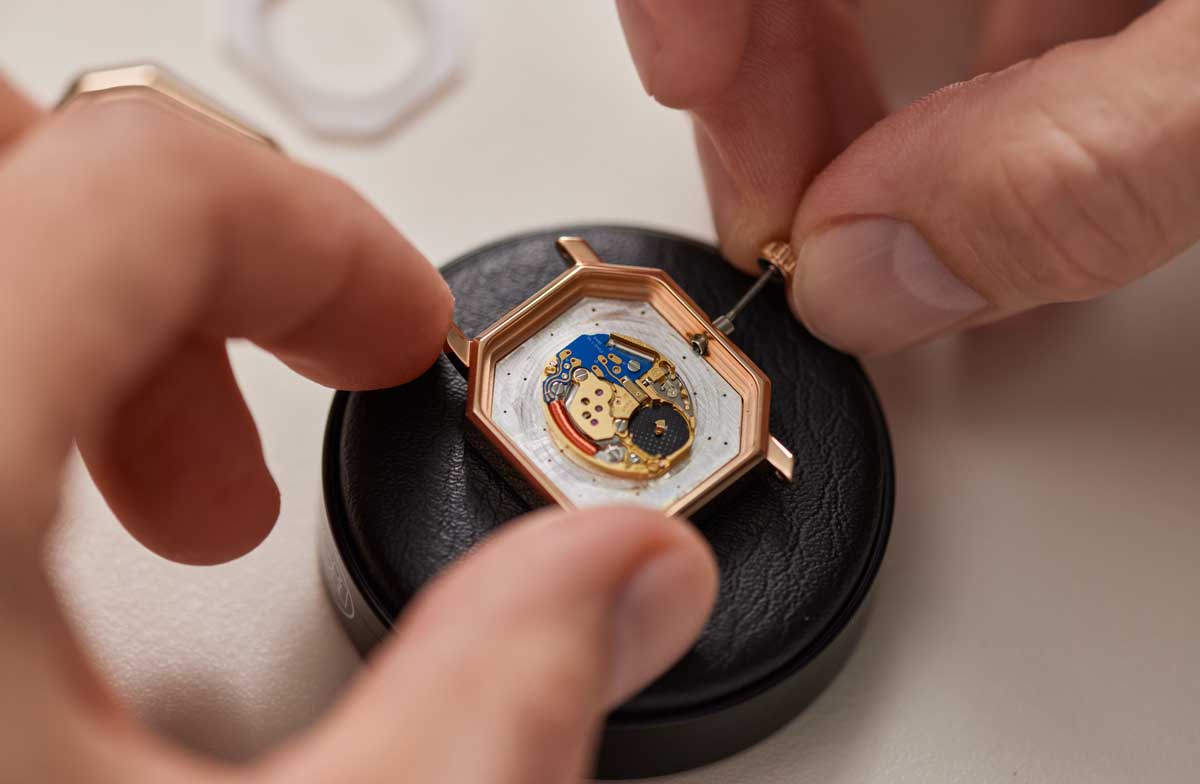
—— What are the advantages and disadvantages of each movement?
Maintenance, durability, precision… Each movement has advantages and disadvantages! For you, we have listed the points that seem most important to know before choosing your watch
—— Mechanical movement
Advantages :
- Prized by connoisseurs who appreciate the purity of its mechanisms
- A fluid display and a smooth running second hand
- Durable mechanisms, limitless if maintained well
- The extra benefit of the automatic version: limitless use thanks to the wrist’s movement
Disadvantages :
- Mechanisms are sensitive to shocks
- Their precision is influenced by environmental factors (magnetism, temperature, gravity…) and it isn’t unusual to gain or lose 15 seconds a day
- These movements require a complete revision about avery 5 years
- They are less precise than quartz watches
- In the case of manual mechanical movements: Require frequent rewinding
—— Quartz mechanical movement
Advantages :
- More precise and more reliable
- More accessible price
- A movement that require little maintenance
- Its finesse which allows for watches with thinner silhouettes
Disadvantages :
- Requires a change of batteries about every 4 or 5 years
Switzerland and watchmaking
—— Why is switzerland the watchmaking kingdom?
Switzerland is hands down the world reference for watchmaking. This country can easily boast about producing the best watches with the best mechanisms. But where does their know-how come from?
This story begins not with a Swiss person but with a French one! Jean Calvin was a French pastor, displaced in Switzerland to defend protestant ideals, who founded a religious movement: calvinism. In 1541, he heads to Geneva to help reform laws and outlaws ostentatious ornaments like jewelry. This is disastrous for the many jewelers of Geneva but they quickly turn to watchmaking!
This change is a rapid success and the reputation of Swiss watchmaking debuts on the international stage. In 1601, the first watchmaking corporation is founded under the name “Watchmakers Guild of Geneva”. History is at work!
Among these watchmakers, a few names are still renowned today. Notably, Vacheron Constantin, Blancpain, Breguet, Omega, Patek Philippe, IWC, Audemars Piguet or Rolex… They’re all Swiss!
—— What is a Swiss Made watch?
Now you know, Switzerland is internationally known for its matchmaking and excellent know-how in this area. Watches with a “Swiss Made” label have an excellent reputation regarding quality, precision and reliability. And the Swiss do their best to maintain the prestige of this label! Not any watch can be labeled as Swiss Made… To obtain this precious label, it must certify where it was manufactured and follow strict requirements.
Firstly, at least 60% of the watch’s added value must be made in Switzerland. In case your economy lessons are far behind you, this means that most of the services necessary to make the watch must be Swiss. This is not the only requirement, the movement must be Swiss, meaning the technical development of the plans and assembling process have been made in Switzerland. Finally, the watch’s movement must be assembled locally, and the final control done in Switzerland. No point in trying to cheat. These rules are rigorously controlled by the Federation of the Swiss Watch industry.
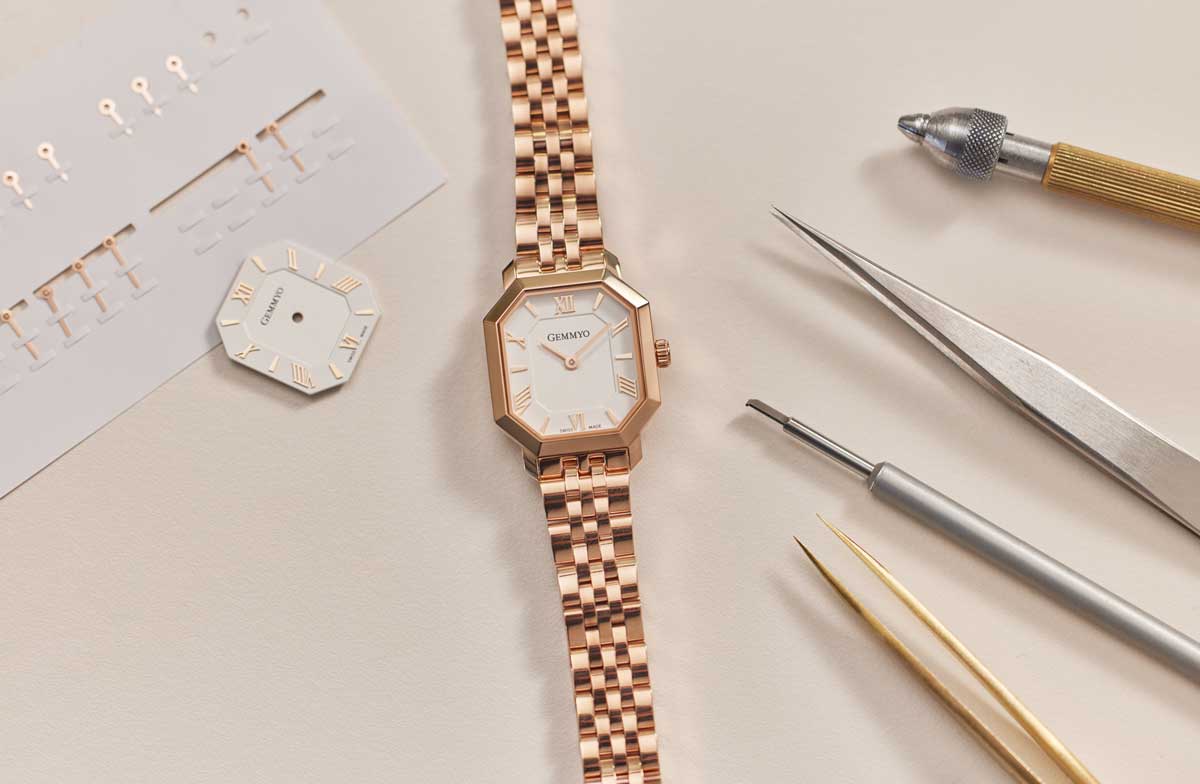
Now that we’ve reviewed a few watchmaking basics, let’s focus on our own Prima model! To discover the history and manufacturing secrets of the first watch model of our Maison, please follow this guide.















